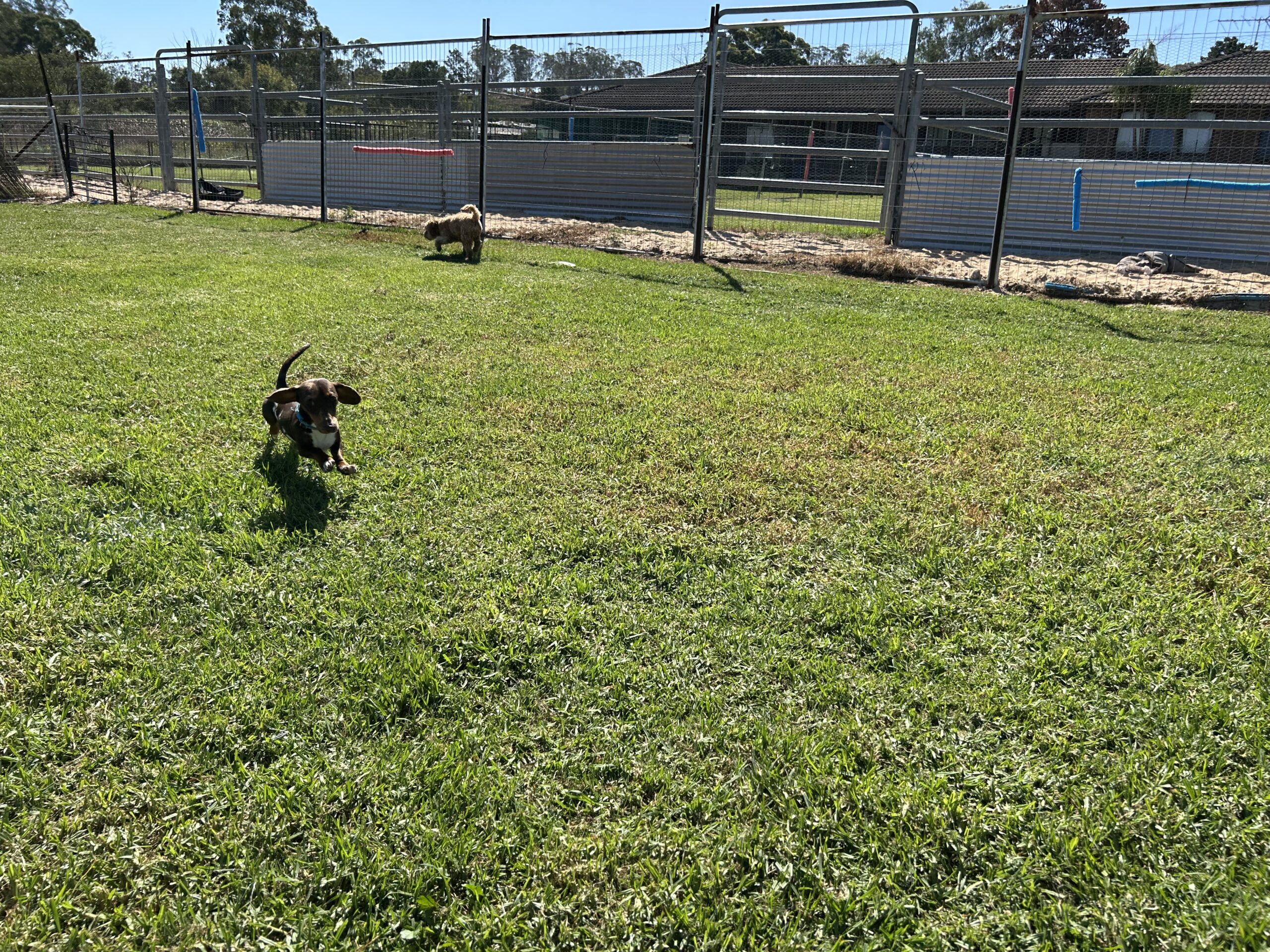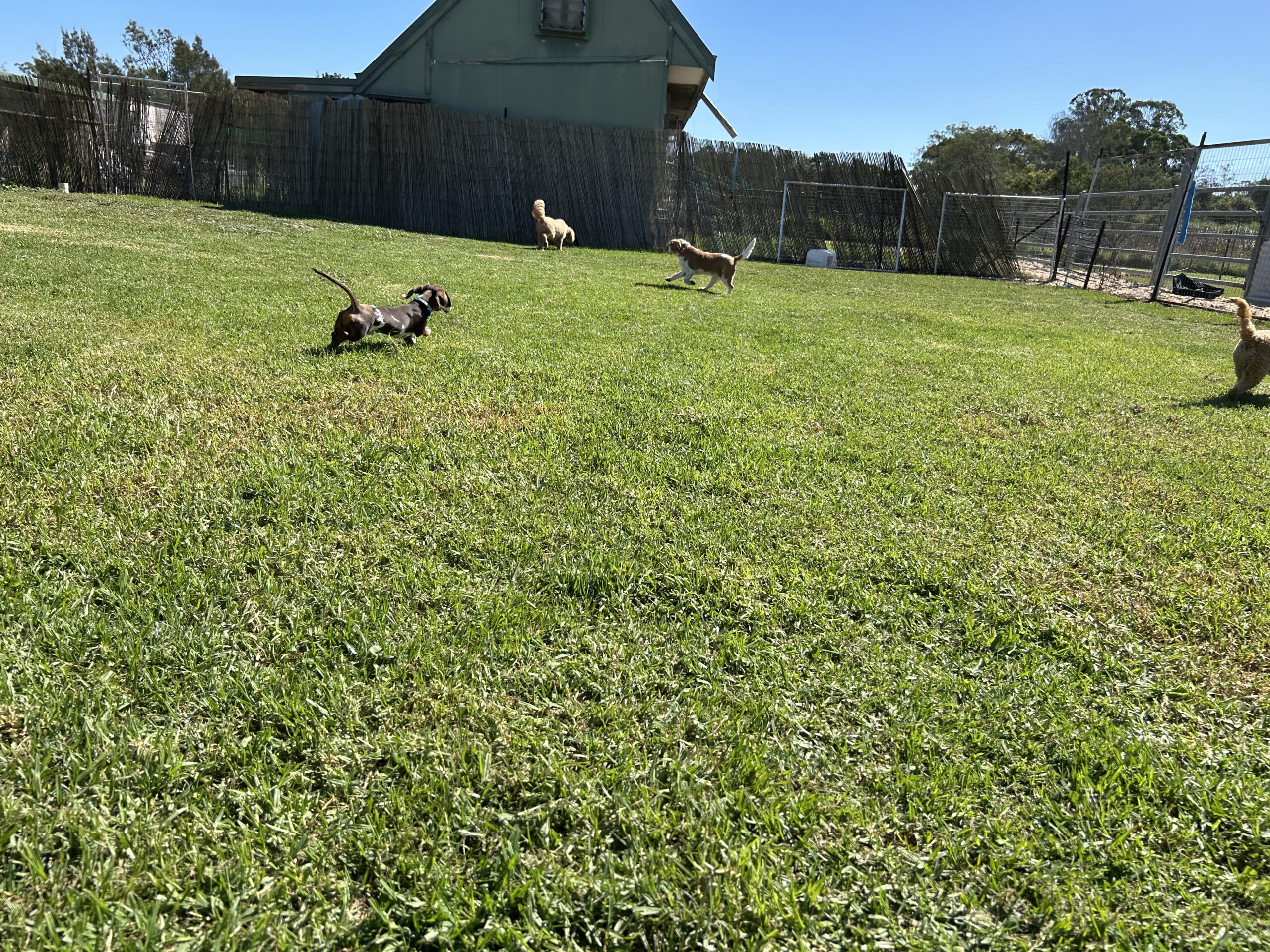Reduce Dog Barking: Joyful Solutions Through Strategic Daycare
Reduce dog barking programs provide targeted interventions addressing the root causes of excessive vocalization, transforming reactive communication into calm confidence.
Key Takeaways: Daycare’s Impact on Excessive Barking
Essential Benefits for Vocal Dogs

| Why It Matters |
|---|
| Professional programs reduce dog barking by addressing causes – Treats the underlying issues, not just the symptom |
| Daycare fulfills mental stimulation needs preventing boredom barking – Bored dogs often bark to create their own stimulation |
| Social needs satisfaction reduces frustration-based vocalization – Dogs with unmet social needs often express it through barking |
| ⏱️ Structured routine decreases anxiety-related vocal behaviours – Predictability significantly reduces stress barking |
| Redirection training teaches alternative communication methods – Dogs learn more appropriate ways to express needs |
| Consistent responses from staff prevent attention-reinforced barking – Prevents the reward cycle that maintains problem barking |
| Proper stimulation reduces hyperarousal-based reactivity – Balanced activity levels promote calmer responses |
| Individual assessment identifies specific barking triggers – Customized interventions target each dog’s unique vocal patterns |
“Your Dog’s Excessive Barking Isn’t Defiance—It’s a Communication Breakdown”
Do your neighbours know exactly when you leave and return home based on your dog’s barking episodes? Have family members stopped inviting you over because your dog’s incessant vocalization makes conversation impossible? Many frustrated owners interpret excessive barking as stubbornness or poor training when it actually represents a sophisticated communication system gone awry.
Research reveals that problematic barking typically stems from five root causes: boredom, fear, territorial behaviour, attention-seeking, and social facilitation. Even more revealing, a groundbreaking study from the University of Melbourne found that 78% of excessive barkers showed significant improvement when their underlying communication needs were properly addressed—without using punishment or suppression techniques.
The good news? Quality reduce dog barking programs can transform even the most vocal canines by providing precisely targeted interventions that address the psychological drivers behind problematic vocalization.
Less Attention-Seeking Behaviour Through Strategic Daycare
Reduce dog barking facilities operate on a fundamental behavioural principle: vocalization represents communication, and excessive barking signals unmet needs that require systematic addressing. Unlike suppression approaches using punishment or anti-bark devices, quality reduce dog barking programs implement sophisticated need-fulfillment and alternative communication protocols.
“Most owners misunderstand the complex communication system that barking represents,” explains Dr. Emma Richardson, veterinary behaviourist. “Effective intervention doesn’t silence dogs—it addresses their underlying needs while teaching more appropriate communication methods.”
Premier reduce dog barking facilities implement evidence-based strategies including:
- Comprehensive vocalization assessment identifying specific barking types
- Custom intervention protocols based on individual barking triggers
- Strategic fulfillment of needs commonly underlying excessive vocalization
- Controlled exposure to barking triggers below reaction threshold
- Alternative communication training for attention and resource requests
- Professional consistency preventing intermittent reinforcement
These aren’t random activities but carefully orchestrated behavioural interventions designed by canine communication specialists. The improved communication skills developed through reduce dog barking programs transfer directly to quieter behaviour at home.
Less Attention-Seeking Behaviour: The Science of Communication Reconditioning
Reduce dog barking programs utilise cutting-edge understanding of canine communication systems to create balanced vocalization patterns. Research from the University of Sydney’s Animal Behaviour Sciences department found that structured daycare intervention reduced problem barking by 63% compared to standard obedience training approaches.
During professionally designed reduce dog barking interventions, your dog’s communication systems undergo sophisticated recalibration:
- Development of appropriate arousal thresholds preventing reactive barking
- Formation of alternative communication strategies for expressing needs
- Extinction of attention-reinforced vocalization patterns
- Satisfaction of underlying needs preventing frustration-based barking
- Establishment of clear communication boundaries and expectations
“These less attention-seeking behaviour techniques create fundamental changes in how dogs express their needs,” notes canine communication specialist Dr. James Wilson. “In quality reduce dog barking settings, we’re not just stopping vocalization—we’re creating more effective communication systems.”
Is Your Dog’s Barking Problematic? Take This Assessment:
- Does your dog bark excessively when left alone?
- Does your dog bark persistently to gain attention or resources?
- Does your dog vocalize reactively to environmental triggers like doorbells or passersby?
- Does your dog’s barking seem difficult to interrupt once started?
- Has your dog’s barking created tension with neighbours or family members?
If you answered “yes” to three or more questions, your dog likely displays problematic vocalization patterns—precisely the behaviours that specialised reduce dog barking programs address through structured communication intervention.
Specialized Techniques for Reducing Barking at Quality Daycares
Premier reduce dog barking facilities implement evidence-based protocols designed specifically for vocal dogs. These aren’t punitive programs but sophisticated communication modification interventions created by canine behaviour specialists.
“The difference between suppression and proper communication training is profound,” explains Dr. Sarah Williams, canine behavioural psychologist. “Proper reduce dog barking programs systematically address the underlying communication needs rather than simply trying to silence dogs.”
Leading less attention-seeking behaviour programs feature techniques such as:
Need Fulfillment Scheduling
Strategic satisfaction of physical, mental, and social requirements that commonly drive excessive vocalization—creating naturally quieter dogs through comprehensive need fulfillment.
Controlled Trigger Exposure
Carefully managed introduction to common barking triggers while maintaining sub-threshold arousal—gradually building tolerance without triggering reactive vocalization.
Alternative Communication Training
Structured activities teaching dogs specific non-vocal methods to request attention, resources, or interaction—providing effective communication outlets that replace barking.
Reinforcement Mapping
Systematic identification and modification of the reward patterns inadvertently maintaining problem barking—breaking the cycles that perpetuate excessive vocalization.
Case Study: Max’s Transformation Through Barking Intervention
Before: Max, a 4-year-old Border Collie/Kelpie cross, represented a classic excessive barker. His family reported non-stop vocalization when left alone, persistent attention-demanding barking at home, and reactive barking at every environmental trigger from doorbells to passing dogs. Multiple complaints from neighbours had created significant household stress.
The Reduce Dog Barking Program: Max began attending a specialised daycare program three days weekly. Staff conducted an initial assessment and created a personalised intervention protocol:
- Week 1: Comprehensive need fulfillment addressing understimulation
- Weeks 2-3: Installation of alternative communication methods for requests
- Weeks 4-6: Graduated exposure to barking triggers with counter-conditioning
- Ongoing: Consistent response patterns preventing intermittent reinforcement
Measurable Results After Eight Weeks:
- 87% reduction in alone-time vocalization
- Significant decrease in attention-demanding barks (replaced with trained signals)
- Markedly improved recovery time after exposure to environmental triggers
- Successful integration into quiet-time activities previously impossible
“The transformation in Max’s communication was remarkable,” reports his owner, Michael. “The reduce dog barking approach completely changed how he expresses his needs. The staff didn’t punish his vocalization—they systematically addressed why he felt the need to bark so much while teaching him better ways to communicate. He’s still expressive, but in much more appropriate ways.”
Signs Your Dog is Developing Better Communication Through Quality Daycare
Not all dog daycare facilities provide genuine vocalization intervention. Many simply manage barking through containment or punishment without addressing underlying communication needs. To determine whether your reduce dog barking program is providing true benefits, monitor these evidence-based indicators:
- Your dog demonstrates increased pause duration between barking episodes
- Vocalization intensity (volume and persistence) decreases over time
- Your dog shows improved recovery after triggering events
- Alternative communication methods emerge for expressing needs
- Your dog exhibits greater discrimination in what triggers barking
- Attention-seeking through vocalization diminishes significantly
- Your dog responds more readily to quiet cues and interruption
Dr. Thomas Chen, veterinary behaviourist, explains: “Effective reduce dog barking intervention produces distinct communication changes that manifest as more appropriate vocalization patterns. When dogs receive proper communication training, the transformation extends beyond simple quietness—they develop fundamental skills in expressing needs appropriately.”
Vocalization Intervention Comparison: Suppression vs. Communication Approach
| Barking Management Needs | Suppression-Based Approaches | Reduce Dog Barking Benefits |
|---|---|---|
| Addressing underlying causes | Ignores root needs driving barking | Systematically fulfills physical, mental and social needs |
| Long-term effectiveness | Temporary reduction often followed by resurgence | Creates lasting communication changes through need fulfillment |
| Emotional impact on dog | Often creates frustration or anxiety | Improves overall wellbeing by addressing actual needs |
| Alternative communication | No replacement behaviours installed | Teaches appropriate alternatives to express needs |
| Trigger sensitivity | Punishment increases reactivity to triggers | Gradually reduces emotional reaction to barking stimuli |
| Owner-dog relationship | Often damages trust and connection | Strengthens relationship through improved communication |
| Professional expertise | Often relies on aversive tools | Uses evidence-based behavioural science principles |
Long-Term Communication Benefits of Barking Intervention Daycare
Reduce dog barking programs focused on communication development offer enduring behavioural benefits that extend throughout your dog’s lifetime. Recent research from the University of Queensland’s Canine Behaviour Centre revealed that dogs receiving structured vocalization intervention maintained their improved communication patterns even when facing novel triggers months after program completion.
“We now understand that appropriate communication training creates permanent changes in expression patterns,” explains clinical animal behaviourist Dr. Robert Thompson. “The skills developed through these programs fundamentally alter how dogs communicate their needs and respond to environmental stimuli.”
Evidence-based reduce dog barking benefits include:
- Development of appropriate arousal thresholds preventing reactive vocalization
- Formation of nuanced communication systems beyond simple barking
- Enhanced emotional regulation during potentially triggering experiences
- Improved general resilience to environmental stressors
- Better social communication with both humans and other dogs
These communication benefits accumulate over time, with each reduce dog barking session contributing to your dog’s behavioural flexibility and appropriate expression.
How Different Barking Types Benefit from Specialised Daycare
Reduce dog barking programming recognises that vocalization issues require individualised approaches based on barking type, triggers, and reinforcement history. Leading facilities conduct thorough assessments to customise intervention protocols:
Attention-Seeking Barkers
Dogs who bark persistently for attention need reduce dog barking programs emphasizing alternative request methods and consistent non-reinforcement of vocalization-based demands.
Anxiety-Based Barkers
Dogs whose barking stems from fear or separation anxiety require reduce dog barking approaches focused on building security and addressing underlying emotional distress.
Alert/Territorial Barkers
Dogs with excessive alert barking benefit from reduce dog barking programs incorporating systematic desensitization to common triggers and clear boundaries for appropriate alerting.
Boredom/Frustration Barkers
Dogs who bark from understimulation need comprehensive reduce dog barking protocols addressing enrichment needswhile teaching appropriate self-regulation.
Barking Reduction Daycare Evaluation Checklist
Not all facilities claiming to help vocal dogs truly understand communication-based intervention. Use this evidence-based checklist when evaluating potential reduce dog barking providers:
- Staff with specific training in canine communication (not just general training)
- Individual vocalization assessment protocols before program development
- Clear understanding of the different functional types of barking
- Positive approach focusing on need fulfillment rather than punishment
- Customised intervention plans based on specific barking patterns
- Professional monitoring and documentation of vocalization changes
- Low staff-to-dog ratios enabling proper supervision and consistency
- Regular owner communication regarding progress and home implementation
Critical Questions for Barking Reduction Daycare Providers
When interviewing potential reduce dog barking facilities, ask these revealing questions to assess their expertise:
- “How do you assess the specific type and triggers of my dog’s vocalization?”
- “What protocols do you implement for teaching alternative communication?”
- “How do you address the underlying needs driving excessive barking?”
- “What systems do you have for ensuring staff consistency with vocal dogs?”
- “How do you create appropriate challenge levels without triggering reactive barking?”
- “What credentials do your staff hold specifically related to vocalization issues?”
The facility’s ability to provide substantive, detailed responses reveals their true commitment to communication development versus facilities offering simple barking suppression.
Conclusion: Transform Vocalization Through Communication Development
Reduce dog barking programs offer a sophisticated alternative to simplistic suppression approaches that often worsen rather than resolve excessive vocalization. By providing customised communication development protocols, these specialised programs address the underlying needs driving problem barking rather than merely attempting to silence the symptom.
Each reduce dog barking session creates measurable improvements in communication patterns. The cumulative effect builds a dog who expresses needs appropriately rather than excessively—transforming their fundamental approach to interaction with both humans and environment.
“When we examine the behavioural evidence,” notes Dr. Jessica Moore, veterinary behaviourist, “the conclusion is clear: structured communication development through specialised reduce dog barking programs represents the most effective intervention for chronically vocal dogs.”
Your dog deserves effective ways to express their needs without resorting to problematic vocalization. Schedule a communication assessment today to discover how a quality reduce dog barking program can transform your dog’s expression patterns through proper communication development.
External Links:
- Canine Boarding Lodge
- Mobile Dog Grooming Services
- Canine Glamour Facebook
- Canine Glamour Instagram
- Canine Glamour TikTok
- Canine Boarding Lodge Facebook
Follow for more:
For more grooming tips visit:
- FB: Canine Glamour
- Instagram: Canine Glamour
- TikTok: Canine Glamour
For more boarding tips visit:




